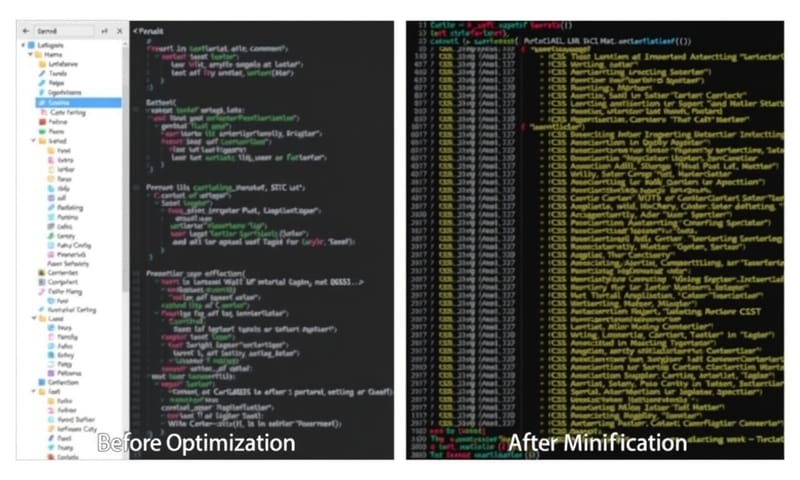所以,CSS 真的會影響 SEO 嗎?
嗯...這問題,每次都有人問。答案是「會」,但不是那種改個標籤、塞個關鍵字就馬上見效的方式。它比較...隱性。
很多人只把 CSS 當成是美化頁面的工具,就是調顏色、改字體大小。但實際上,它跟網站的載入速度、使用者體驗,甚至是 Google 爬蟲怎麼「看」你的網站,都有關係。 說真的,CSS 就像建築的鋼筋,平常看不到,但決定了房子的穩固與否。
如果 CSS 寫得不好,檔案太大、太亂,瀏覽器就要花很多時間去解讀和渲染,頁面就會變慢。 然後,使用者等得不耐煩就走了。Google 看到這種情況,自然會覺得你這個網站體驗不好。這就是所謂的「核心 Web 指標」([Core Web Vitals])會變差的原因。
重點一句話
簡單講,優化 CSS 能讓頁面載入更快、更穩定,這能改善使用者體驗和爬蟲效率,進而對 SEO 排名產生正面影響。
從爬蟲的角度看這件事
大家比較常聊使用者體驗,但很少人會從 Googlebot 的角度想。爬蟲其實很忙,它有一個「抓取預算」([Crawl Budget])可以用在你網站上。 說白了,就是它分配給你網站的時間和資源是有限的。
如果你的 CSS 檔案又大又多,爬蟲每次來都要下載、處理這些東西,這就很花時間跟資源。 結果可能就是,它還沒把你網站的重要內容爬完,預算就用完了,然後就離開了。這對大型網站,特別是電商網站來說,影響很大。 想像一下,你有一堆新產品頁面,但爬蟲總是不來,或是來了也爬不完,那這些頁面就很難被索引,更不用說排名了。
所以,壓縮 CSS、合併檔案,不只是為了使用者,也是為了讓爬蟲的工作更有效率。 讓它能把有限的預算,花在刀口上,也就是你最重要的內容頁面。

實際怎麼動手?幾個思考點
好,理論講完了。那實際上可以怎麼做?
最基本的就是「壓縮」(Minification)。這很單純,就是把 CSS 檔案裡的空白、換行、註解都拿掉,讓檔案變小。 現在很多工具都能自動做這件事。
再來是「合併檔案」。如果你有很多支小小的 CSS 檔,瀏覽器就要發送很多次請求去下載它們。 把這些檔案合併成一個,可以減少請求次數,速度會快一點。
不過,現在的網站開發,尤其是在台灣,很多專案開始用像 React 或 Vue 這種框架,CSS 的處理方式也變了。像 CSS-in-JS 或 Scoped CSS,它們的打包工具(例如 Webpack)其實已經在背後幫你做了很多優化。 所以重點可能不是手動去合併,而是去檢視你的打包設定對不對。
跟國外那種比較傳統的 WordPress 網站相比,台灣這邊很多新創或科技公司用的技術棧很不一樣,優化的切入點也不同。Google 的 web.dev 提供了很多通用指南,但你還是得對應到自己的專案情境。例如,有些香港的網頁設計公司,他們在服務介紹裡就會特別強調 SEO 優化是整合在網站架構裡的,這表示他們從一開始就考慮到了這些技術細節。
[Critical CSS]... 是萬靈丹嗎?
然後就是進階一點的作法,叫做「[Critical CSS]」,或稱「關鍵路徑 CSS」。
它的概念是,把使用者一打開網頁「馬上會看到」的那一塊畫面(Above-the-fold)所需要的 CSS 樣式,直接內嵌到 HTML 的 `
` 裡面。 其他的樣式,例如頁尾、或是要往下捲動才看得到的內容,就用非同步的方式延後載入。這樣做的好處是,瀏覽器不用等所有 CSS 都下載完才開始渲染畫面,使用者可以非常快地看到頁面的主要內容,體感速度會差很多。 這對 LCP(最大內容繪製)指標的改善很有幫助。
但這不是沒有代價的。首先,你要準確地分離出哪些是 [Critical CSS],這件事本身就很麻煩,雖然現在有工具可以幫忙。 再來,如果沒弄好,可能會造成頁面載入時閃爍一下(Flash of Unstyled Content),就是先看到沒套樣式的內容,然後才變正常,使用者體驗反而更差。 而且,如果你的頁面樣式經常變動,你就要一直去更新你的 [Critical CSS],維護起來也是個成本。

工具跟流程的選擇
說到工具,其實選擇很多。從最簡單的線上壓縮工具,到整合在開發流程裡的 PostCSS、Sass,或是像 Cloudflare 這種 CDN 服務,它們也提供自動壓縮 CSS 的功能。 台灣的網站開發者,很多人習慣用 VS Code,裡面也有很多擴充套件可以幫忙處理。
下面我整理一個簡單的比較表,但這只是個大概,實際還是要看團隊習慣。
| 優化方式 | 優點 | 缺點 / 風險 | 適合情境 |
|---|---|---|---|
| 手動壓縮/合併 | 嗯...就是...不用裝工具?很直覺。 | 超級沒效率,很容易出錯。現在誰還這樣搞... | 可能只有改一兩個超小的靜態頁面吧。 |
| 使用建置工具 (Webpack/Vite) | 可以自動化,跟開發流程整合得很好。彈性也大。 | 設定起來有點學問,尤其是複雜的專案,搞錯了可能反而變慢。 | 基本上是現代前端開發的標配了。 |
| CDN 自動優化 (如 Cloudflare) | 最無腦,按個鈕就幫你處理好了。不用動程式碼。 | 彈性比較小,沒辦法做太細緻的客製化。有時候效果不比自己調校好。 | 給那些不想碰程式碼,或是用 WordPress 之類平台的人。 |
| 導入 [Critical CSS] | 對首屏載入速度提升最明顯,分數會很好看。 | 維護成本高,設定複雜。沒弄好可能會有樣式閃爍問題。 | 對速度有極致要求的網站,比如媒體首頁、大型電商活動頁。 |
常見的誤解
最後,講幾個大家常有的誤解。
第一個是「只要用了壓縮,速度就會飛天」。其實壓縮只是基本功,它能帶來的提升有極限。真正影響速度的大魔王,通常是圖片、JavaScript,或是伺服器回應時間。
第二個是「CSS 完全不會影響 CLS(累計版面配置位移)」。這也不對。如果你用 JavaScript 動態插入一些元素,但沒有先用 CSS 預留好空間,那內容就會跳動,CLS 分數就會很難看。 另外,網頁字型載入時,如果備用字型跟你的目標字型大小差太多,也會造成版面位移。 所以 CSS 的寫法跟 CLS 息息相關。
第三個,「把所有 CSS 都內聯到 HTML 就最快」。千萬不要。這樣會讓你的 HTML 檔案變得超大,反而減慢了初始的下載和解析。 而且完全沒有快取效益。這跟 [Critical CSS] 的精神是完全背道而馳的。

總之,CSS 優化算是一個...嗯,有點像整理房間。平常可能感覺不到差異,但當你要找東西(Google 要找內容)或是有客人來(使用者造訪)的時候,一個乾淨整潔的房間,跟一個亂七八糟的房間,體驗就完全不同了。
這不是 SEO 的全部,但它是技術 SEO 裡,一個不能忽視的基礎環節。
你都怎麼優化 CSS?
想問問大家,你目前用的是哪種 CSS 優化方法?單純壓縮,還是有用到 [Critical CSS] 或其他更進階的技巧?在下面留言分享看看吧,我也很好奇現在業界的普遍作法。



